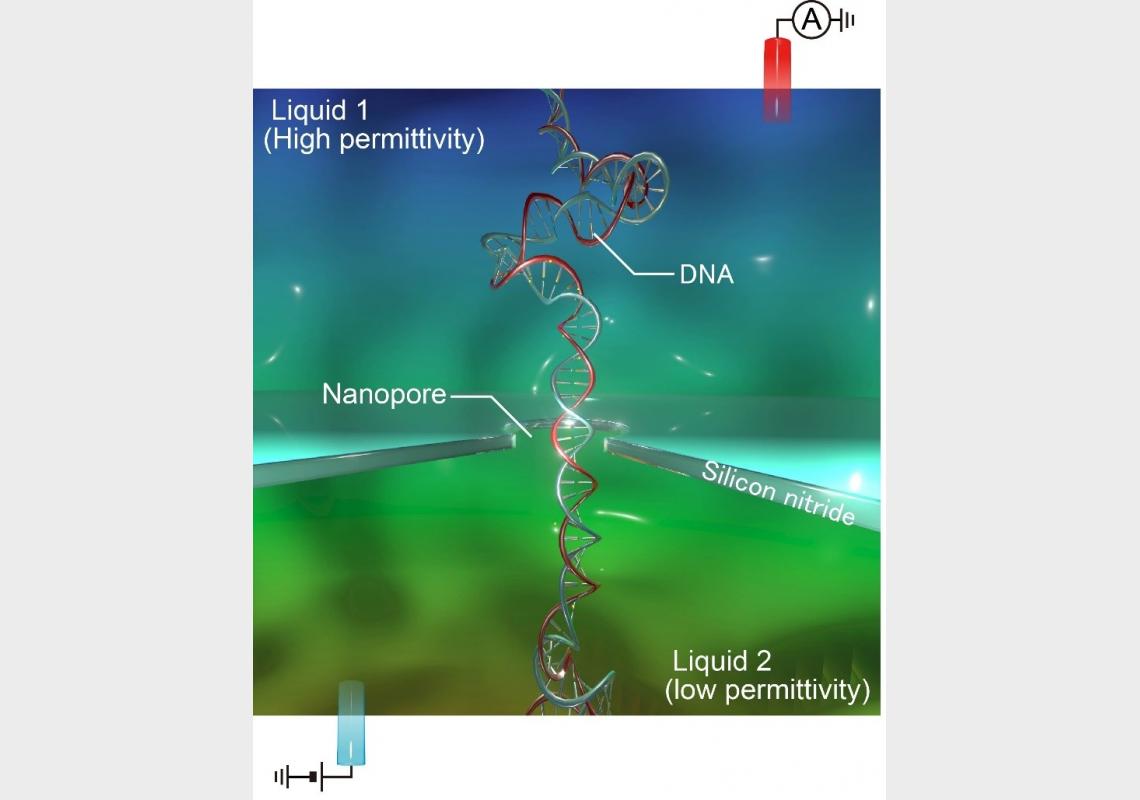Liquid permittivity gradient-mediated ionic current measurements for enhanced sensitivity of nanopore DNA sensors.
A research group led by Osaka University found a simple way to facilitate detections of single DNA molecules in silicon nitride nanopores, integration of which with compact electronics will be straightforward and could revolutionize genomic sequencing
Osaka, Japan – Genomic sequencing has revolutionized our understanding of medicine and evolution, such as identifying hereditary anomalies. Arrays of nanometer-sized holes—nanopores—in silicon nitride can in principle dramatically speed up and lower the cost of such analyses. However, DNA molecules transit such nanopores far too quickly for detection causing only weak signals that are often difficult to analyze. Now, a research study led by The Institute of Scientific and Industrial Research (SANKEN) at Osaka University has utilized a method to enhance DNA detection in nanopores by manipulating the electrical properties of the DNA within and slowing down its transit.
The direct compatibility of silicon nitride with compact electronics has long attracted researchers at the interface of biology and technology. However, the use of corresponding nanopores for DNA sequencing has faced bottlenecks that are difficult to overcome. "DNA usually moves through the nanopores too fast, and the instrumental response is too weak, to read the genome sequence," explains Makusu Tsutsui, lead author. "Our research could change this. Simply using glycerol, instead of water, on one side of the nanopores enables detection of single DNA molecules."
The researchers' nanopore-based DNA detection strategy monitors the change in electrical current upon transit of a DNA molecule through the nanopore. Water is commonly used on both sides of the nanopore. By using glycerol on one side, the flow of solvent through the nanopore substantially changes. The way in which this altered flow of solvent modifies the ion flow through the nanopore increases the intensity of the instrument’s readout so that DNA molecules can be detected.
"The difference in viscosity between the two ends of the nanopore is what makes everything work," says Tomoji Kawai, senior author. "The altered fluid flow through the channel changes the electrical response of the DNA within the channel, and sufficiently slows down DNA transit for further enhanced instrumental detection."
One limitation of this method is that fast current fluctuations add substantial noise to the instrumental readout. The researchers noted that mathematical tools such as wavelet transforms could be used to address this, because these tools are ideal for analyzing transiently fluctuating DNA electrical response data.
The detection of DNA molecules may also facilitate genomic sequencing, which provides a comprehensive readout of the DNA composition. Perhaps with such capabilities, researchers will be able to integrate solid-state nanopores with compact electronics for unprecedented functionality, such as identifying the real-time onset of hereditary anomalies.
###
The article, "Ionic signal amplification of DNA in a nanopore," was published in Small Methods at DOI: https://doi.org/10.1002/smtd.202200761
About Osaka University
Osaka University was founded in 1931 as one of the seven imperial universities of Japan and is now one of Japan's leading comprehensive universities with a broad disciplinary spectrum. This strength is coupled with a singular drive for innovation that extends throughout the scientific process, from fundamental research to the creation of applied technology with positive economic impacts. Its commitment to innovation has been recognized in Japan and around the world, being named Japan's most innovative university in 2015 (Reuters 2015 Top 100) and one of the most innovative institutions in the world in 2017 (Innovative Universities and the Nature Index Innovation 2017). Now, Osaka University is leveraging its role as a Designated National University Corporation selected by the Ministry of Education, Culture, Sports, Science and Technology to contribute to innovation for human welfare, sustainable development of society, and social transformation.
Website: https://resou.osaka-u.ac.jp/en



